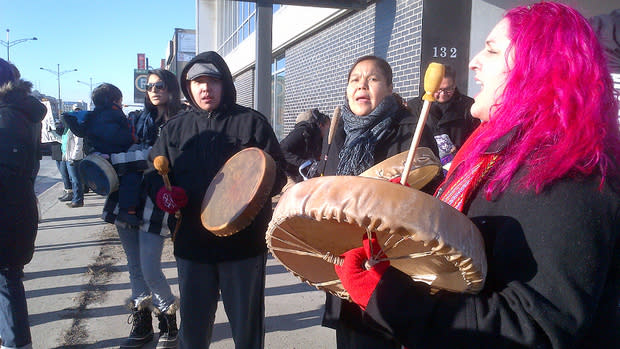 Daily Brew
Daily BrewProtests in Victoria, Saskatoon show Idle No More movement hasn’t vanished

Idle No More may not be commanding the national attention it had a month ago but it hasn't disappeared, as evidenced by protests in Saskatchewan, B.C. and Ontario.
A group of Idle No More protesters staged a one-hour demonstration in Saskatoon City Council chambers on Monday, standing in the back of the room with duct tape over their mouths, according to NewsTalk650.
The silent demonstration was aimed at protesting First Nations' relationship with government on issues that affect them, said organizer Alex Davenport.
[ Related: Idle No More protesters interrupt meeting between chiefs, feds ]
“I don’t think the Idle No More Movement is getting a voice when it comes to things like the XL (heavy oil) pipeline, this is a cultural genocide we’re speaking of right now and it’s serious,” said Davenport.
Coun. Mairin Loewen, spotting the protesters, said she thought city council had a good relationship with local First Nations governments but would benefit if they became more involved in municipal governance.
“We increasingly have a large aboriginal population in the city and lots of off-reserve people living in Saskatoon so we should be making the effort to offer opportunities to those people who come to the city looking for employment of education," she said.
On Sunday, members of the Kwakwaka’wakw First Nation from Alert Bay, B.C., staged a rare shaming ritual aimed at the federal government on the steps of the legislature in Victoria.
The ritual, known as "copper cutting," had not been performed for decades, according to the Victoria Times Colonist.
[ Related: Has the Idle No More movement fizzled out? ]
A copper plaque traditionally used to measure the status, wealth and power of Kwakwaka'wakw chiefs was broken by hereditary Chief Beau Dick, who had walked from Quatsino, on northern Vancouver Island, to Victoria with family members and supporters, the Times Colonist said.
“The copper is a symbol of justice, truth and balance, and to break one is a threat, a challenge and can be an insult,” Dick said before the ceremony. “If you break copper on someone and shame them, there should be an apology.”
The shaming, supported by Idle No More, was aimed at getting people to think about the need to protect the environment and to stop what Dick called "cultural genocide" against First Nations, the Times Colonist said.
Dick credited Idle No More with helping people make the connections between such issues as corrupt corporate values and disappearing salmon stocks.
In Hamilton, Ont., Idle No More supporter He Carries the Strength of 10 Buffalo staged a four-day fast in front of city hall. After participating in other Idle demonstrations, including a highway blockade, he felt disruptive protests were doing more harm than good.
“Stopping the trains and stopping the cars is just hurting the people of Canada — it's not getting to the prime minister or anyone that's important enough to stop what's going on,” he told CBC News. "This is my way of saying we don't need to stop people."
Idle No More sprang up last year as a grassroots movement aimed at bringing First Nations' grievances to public attention outside the traditional aboriginal leadership structure.
It peaked in early January during media coverage of Attawapikat Chief Teresa Spence's hunger strike in Ottawa. Prime Minister Stephen Harper then met with chiefs of the Assembly of First Nations to hammer out a process to address specific concerns.
[ Related: Senator Patrick Brazeau mocks Chief Theresa Spence at Tory fundraiser ]
According to an analysis of social-media traffic reported by Postmedia News, online activity has largely fizzled out. But the movement's supporters say it hasn't disappeared, only shifted its focus.
"We're in this for the long haul," spokeswoman Pam Palmater told Postmedia News. “You’ll see it take different forms at different times, but it’s not going away anytime soon.”


